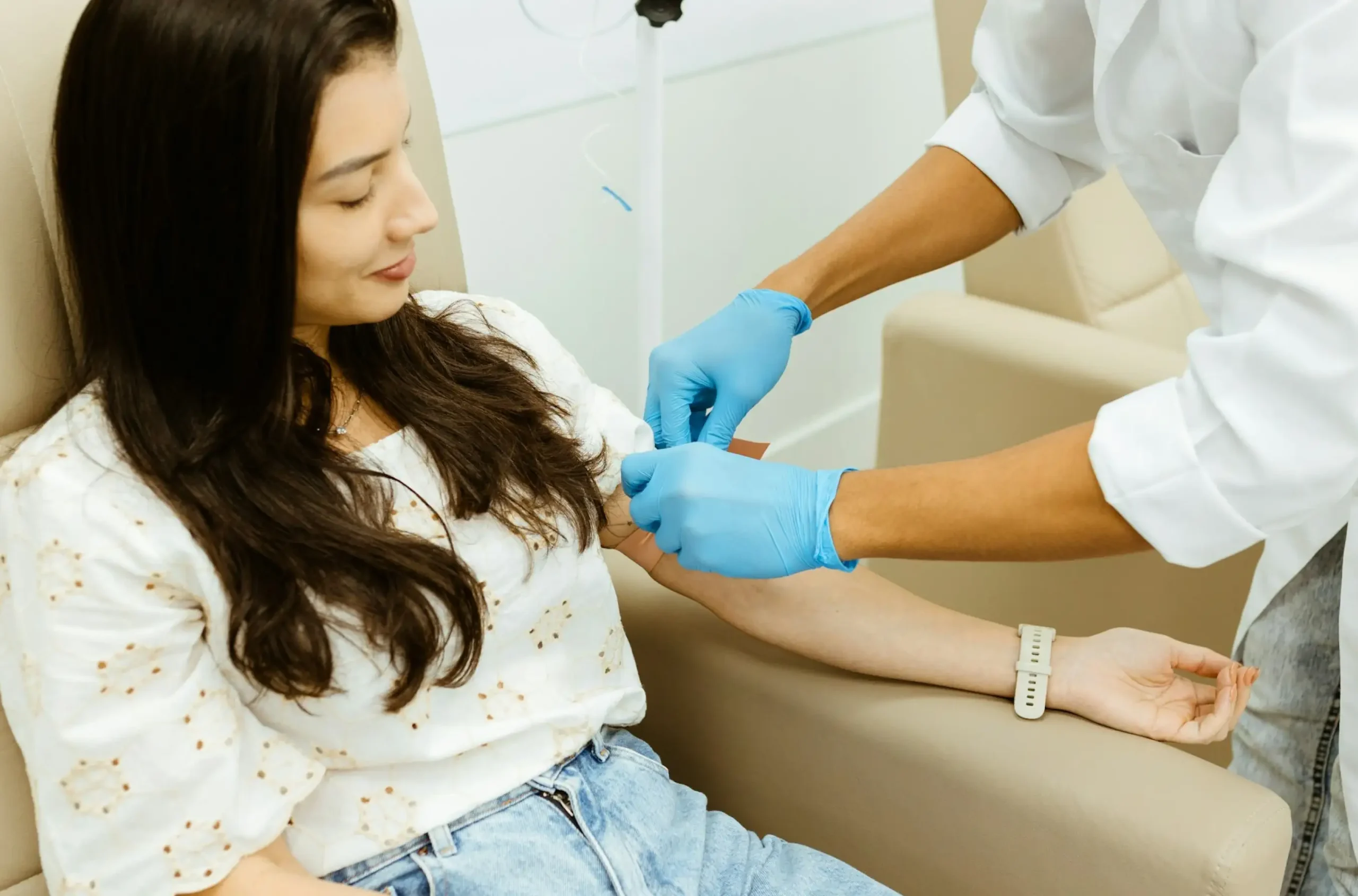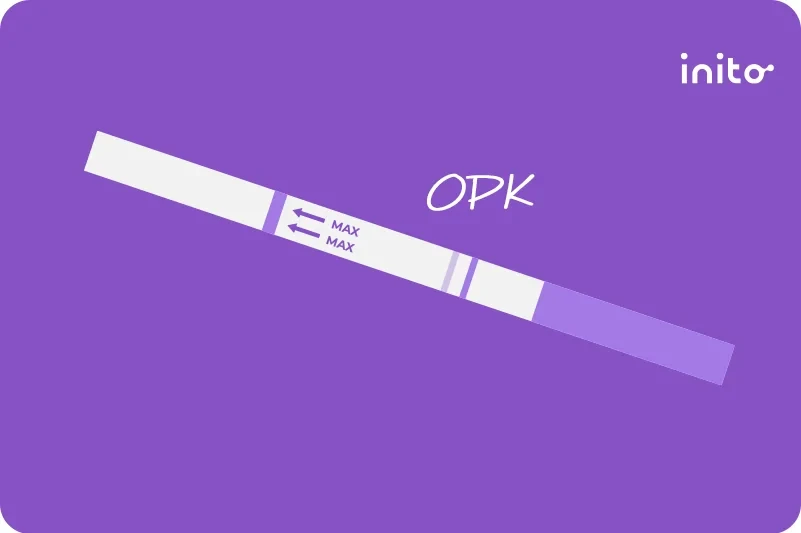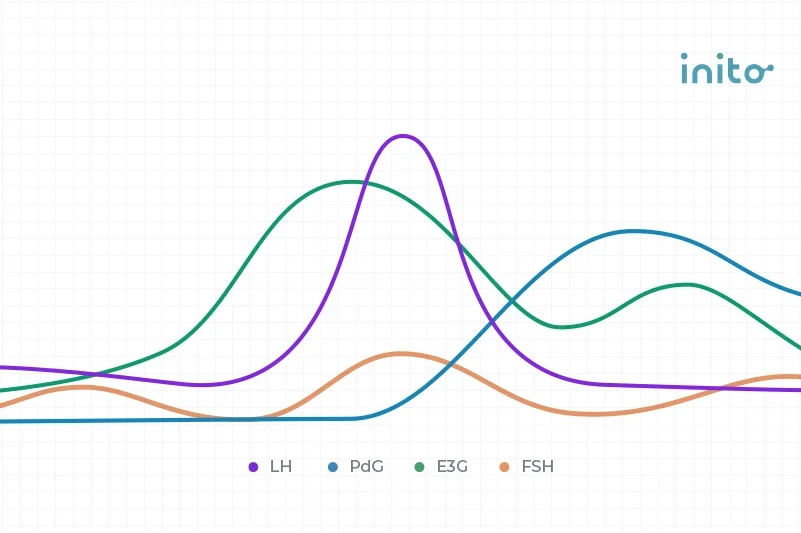Content table
If you’re TTC (Trying To Conceive), you’ll want to keep tabs on your progesterone. It’s the only hormone that confirms ovulation. And without ovulation, you can’t get pregnant!
Progesterone is a steroid hormone made by your adrenal glands and ovaries. It’s the dominant hormone during the second half of your menstrual cycle (luteal phase).
And the truth? Your progesterone levels after ovulation can make or break your chances of pregnancy. The thing is, progesterone levels change from day to day. So what’s ‘normal’ isn’t always clear-cut.
But don’t worry – we’re here to clear up the confusion. Read on to learn what progesterone levels look like before and after ovulation.
Progesterone and ovulation
During the first half of your menstrual cycle, progesterone levels are low. After ovulation, all that changes.
Once you ovulate, the follicle that holds the egg becomes the corpus luteum. This temporary organ secretes progesterone, causing your progesterone levels to rise.
Progesterone’s rise helps thicken the uterine lining so it’s easier for a fertilized egg to implant. Low progesterone levels can make it harder to get pregnant.
In general, progesterone levels in blood above 5 ng/mL and PdG levels in urine above 5 ug/mL over three consecutive days help confirm ovulation.
But if you’re TTC, it’s ideal if they’re higher. Research shows women with blood progesterone levels over 10 ng/mL in the mid-luteal phase have higher pregnancy rates.
Progesterone levels before and after ovulation
Since progesterone plays an important role in pregnancy, having adequate levels is crucial if you’re TTC. But before we dive deeper, please remember that progesterone fluctuations are totally normal.
Progesterone levels vary from person to person and day to day. So don’t expect your progesterone levels to look like your BFF’s – or for each day to look the same, cause they won’t! With that in mind, the chart below will give you an idea of what progesterone levels look like before and after ovulation.
Progesterone levels chart
Phase of menstrual cycle | Serum progesterone levels | PdG (urine metabolite of progesterone) levels |
Before ovulation | 0.1 to 0.7 ng/mL | 0-3 ug/mL |
After ovulation | 2 to 25 ng/mL | 6 to 40 ug/mL |
Before ovulation

As mentioned, your progesterone levels are low before ovulation. Normal serum progesterone levels before ovulation are between 0.1 to 0.7 ng/mL. If you test PdG (a urine metabolite of progesterone), it should be between 0-3 ug/mL before ovulation.
After ovulation
Progesterone levels rise after you ovulate and peak about one week after ovulation. Let’s break it down day by day.
1-6 Days past ovulation (DPO)
Right after ovulation, the Luteinizing Hormone (LH) helps the empty follicle transform into the corpus luteum. Its main job is to secrete progesterone.
This causes a gradual rise in progesterone between 1-6 DPO. Progesterone’s rise helps the uterine lining grow thicker, so it’s primed for a fertilized egg to implant.
For some women, progesterone starts rising right after ovulation. For others, the rise in progesterone may take a few days. That’s why it’s essential to know your hormone values and your hormone trends.
Implantation hasn’t occurred yet at this time. So progesterone levels tend to be the same in pregnant and non-pregnant women.
6-10 DPO
Progesterone levels usually peak between 6 and 8 days after ovulation and stay elevated. This is deliberate, as high progesterone levels during this period make it easier for a fertilized egg to attach to the uterine lining.
After an egg is fertilized, it takes about 6 days for it to travel from the fallopian tube to the uterus. Once there, it begins the implantation process, burrowing into the uterine wall.
Implantation can happen anytime between 6 and 12 days past ovulation. However, 8-10 DPO is the most common
For implantation to be successful, high levels of progesterone are a must. This nourishes the uterine lining to help the fertilized egg stick.
Read More: How to Make Implantation Successful
11+ DPO
If a fertilized egg successfully implants, congrats! You’re officially pregnant. After implantation, the placenta begins forming and secretes hCG (human chorionic gonadotropin) – the hormone pregnancy tests look for.
hCG’s rise tells the corpus luteum to keep producing progesterone to nourish your developing embryo.
Around 10 weeks into pregnancy, the placenta takes over complete production of progesterone. Progesterone continues to rise throughout pregnancy, before peaking in the third trimester.
But if implantation doesn’t occur, the corpus luteum disintegrates. This causes your progesterone levels to drop, triggering the start of your period.
Progesterone and pregnancy
Studies show implantation is more successful when progesterone is 10 ng/mL or higher. If progesterone levels are too low, it can interfere with implantation and make it more difficult to get pregnant.
So, what do normal progesterone levels in blood look like during pregnancy? The chart below will give you an idea:
Stage of menstrual cycle or pregnancy | Serum progesterone level |
Follicular phase | 0.1 to 0.7 ng/mL |
Luteal phase | 2 to 25 ng/mL |
First trimester | 10 to 44 ng/mL |
Second trimester | 19.5 to 82.5 ng/mL |
Third trimester | 65 to 290 ng/mL |
Read More: Progesterone Levels by Week: What’s Normal During Pregnancy?
This brings us to our next important question
How do I test my progesterone levels?
You can take a progesterone blood test or a urine PdG test. You’ll need to visit your healthcare provider for a blood test at the right time to get accurate results.
Ideally, progesterone blood testing should be done 7 days after ovulation. If you have a textbook cycle length of 28 days, then this is day 21 of your cycle. However, only 20% of the cycles have ovulation on day 14. Hence knowing your ovulation day and then testing 7 days later is the right way to go about it.
You can also measure PdG, a urine metabolite of progesterone, with an at-home urine test like Inito. Inito measures your PdG to confirm you ovulated. And unlike threshold-based tests, Inito allows you to see your actual hormone values.
Simply look for a consistent rise in your PdG to confirm ovulation. No doctor visits or needles required.
Inito also measures FSH, LH, and estrogen to give you a complete picture of your fertile window. That way, you know exactly when to have sex if you’re TTC.
While Inito can confirm if you’re ovulating, it’s not meant to diagnose or monitor pregnancy. Nor can you use it to track progesterone during pregnancy or the two-week wait.
See how your hormone chart might look like!
Answer some questions to help us provide you a free personalized hormone chart customized to your hormonal health and conditions
What if my progesterone levels don’t peak?
If your progesterone levels don’t rise enough after your LH surge, it could be a sign of anovulation. This is when your ovaries don’t release an egg during your menstrual cycle. Anovulation is the leading cause of infertility. It’s to blame for around 30% of all female infertility.
Remember, progesterone production relies on your corpus luteum, which forms from the empty follicle that held the egg. If you don’t ovulate, the corpus luteum doesn’t create that month, and progesterone levels stay low.
That said, please know that progesterone levels are dynamic. Everyone’s peaks are unique and look different from month to month. Consult your doctor if you have any questions about your progesterone levels.

FAQs
As mentioned, progesterone levels peak in the luteal phase at roughly 6 to 8 days after ovulation. However, if you get pregnant, progesterone keeps rising and peaks in the third trimester.
Once you ovulate, progesterone levels rise during the luteal phase before falling back to baseline towards the end. This marks the start of your next period.
If your progesterone dips sooner than 11 days after ovulation, it could be a sign of luteal phase defect. This is when the corpus luteum doesn’t produce enough progesterone.
Read More: Your Guide to Luteal Phase Defects
If you become pregnant and your progesterone level drops, it could be a sign of miscarriage. In this case, it’s important to see your doctor as soon as possible.
Was this article helpful?
- Cable JK, Grider MH. Physiology, progesterone. In: StatPearls. StatPearls Publishing; 2021.
- Oettel M, Mukhopadhyay AK. Progesterone: the forgotten hormone in men? Aging Male. 2004;7(3):236-257.
- Leiva R, Bouchard T, Boehringer H, Abulla S, Ecochard R. Random serum progesterone threshold to confirm ovulation. Steroids. 2015;101:125-129.
- Pletzer, Belinda. (2019). Sex Hormones and Gender Role Relate to Gray Matter Volumes in Sexually Dimorphic Brain Areas. Frontiers in Neuroscience. 13. 10.3389/fnins.2019.00592.
- Lek SM, Ku CW, Allen Jr JC, et al. Validation of serum progesterone <35nmol/L as a predictor of miscarriage among women with threatened miscarriage. BMC Pregnancy and Childbirth. 2017;17(1):78.
- Nakajima ST, McAuliffe T, Gibson M. The 24-hour pattern of the levels of serum progesterone and immunoreactive human chorionic gonadotropin in normal early pregnancy. J Clin Endocrinol Metab. 1990;71(2):345-353.
- Holesh JE, Bass AN, Lord M. Physiology, ovulation. In: StatPearls. StatPearls Publishing; 2021.












